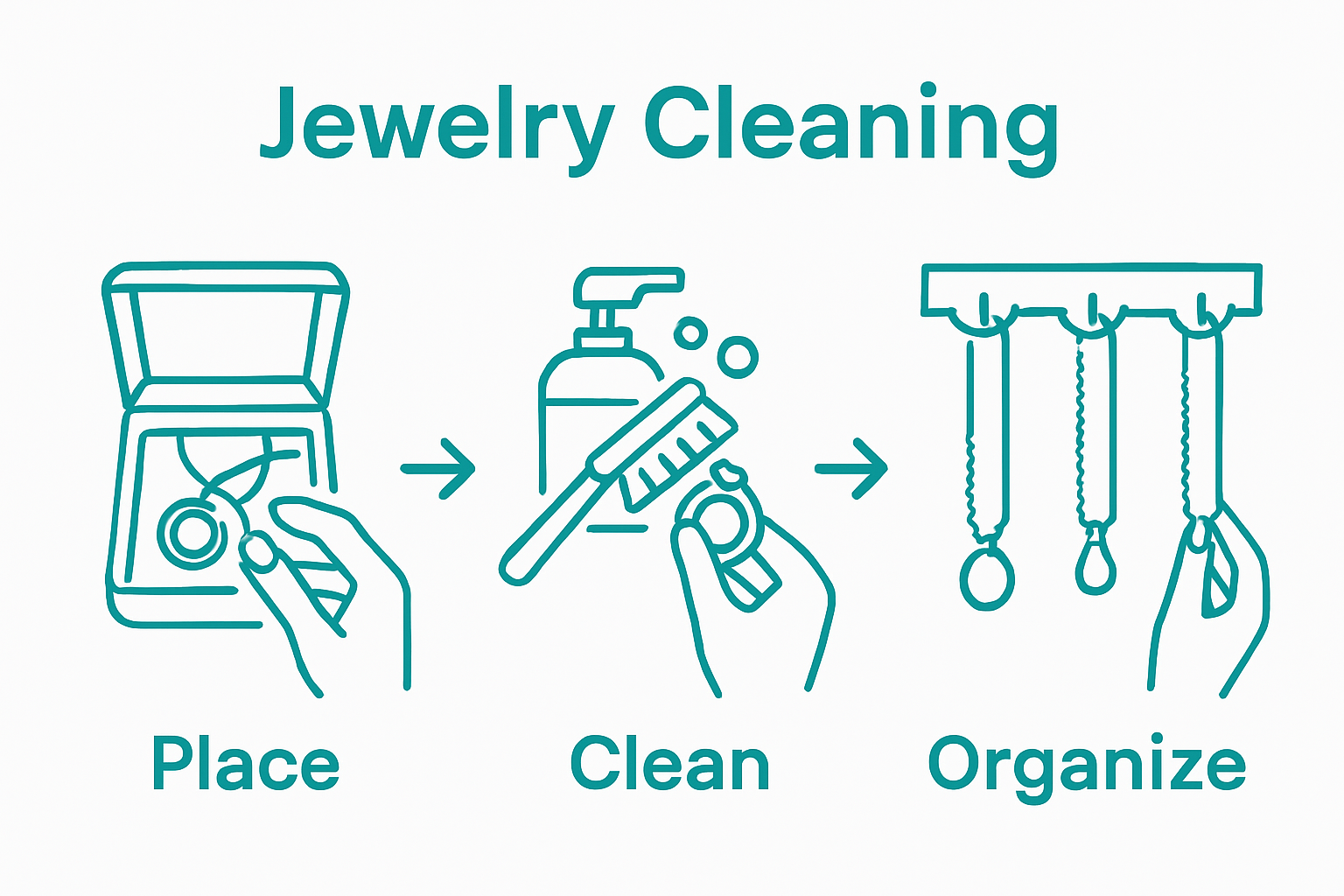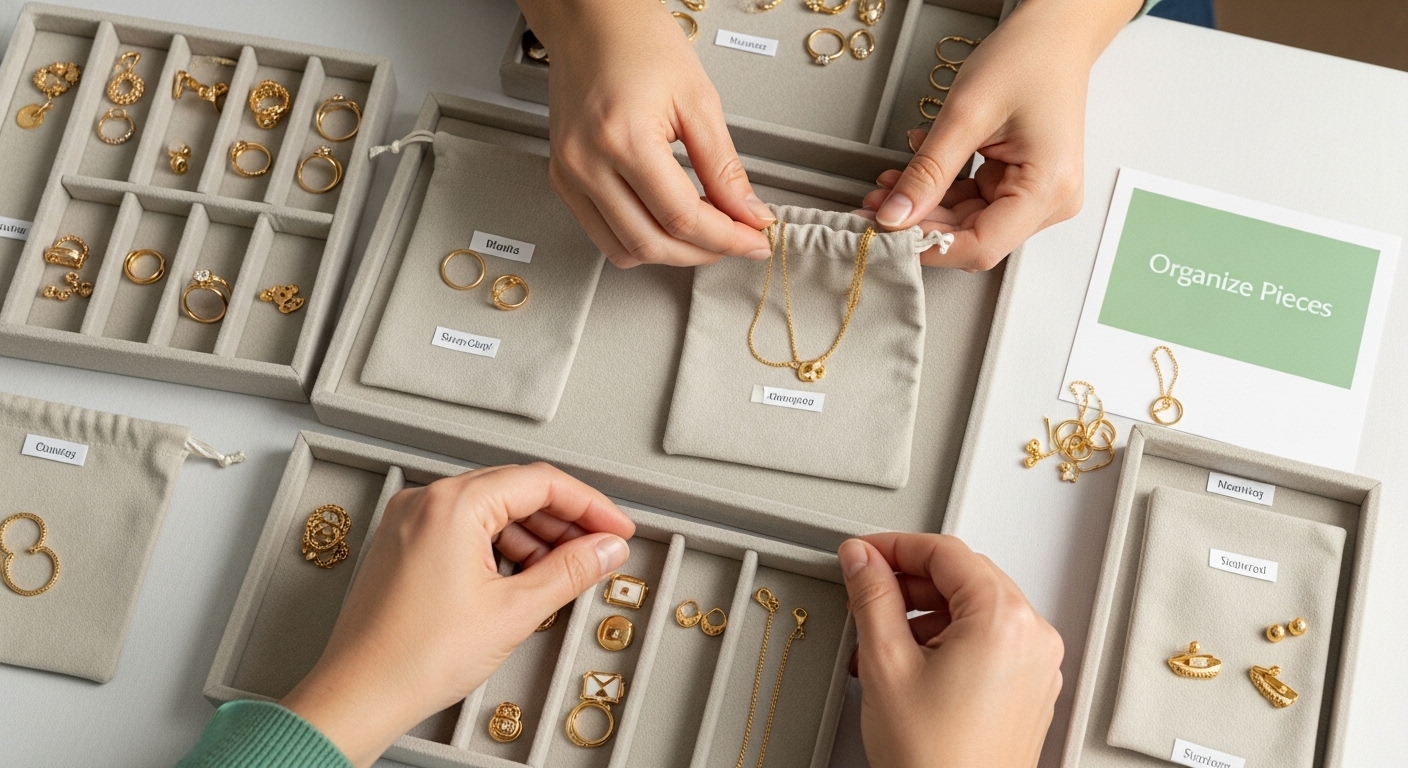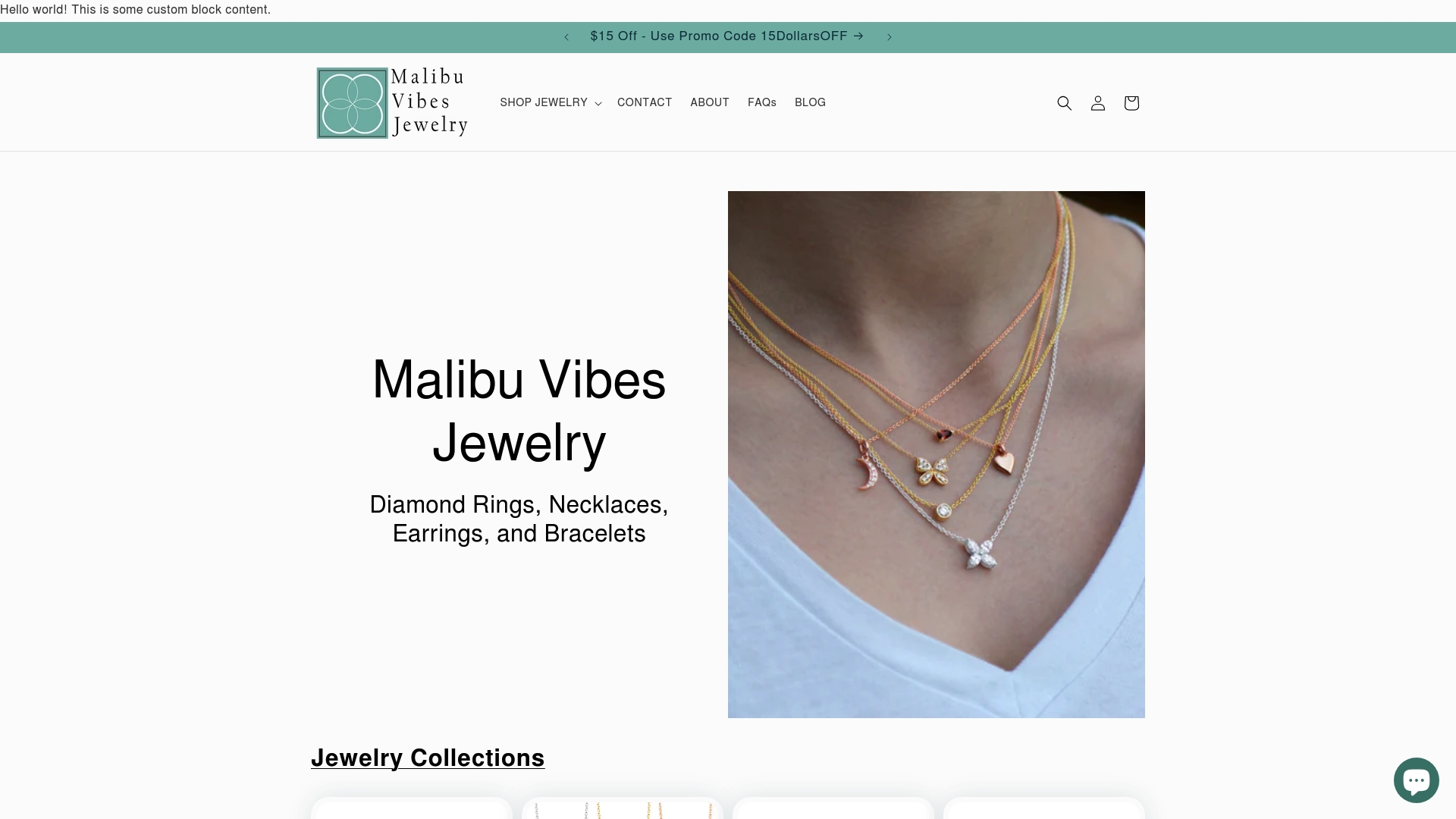Everyone loves the shine and elegance of gold jewelry. Research shows that improper storage can reduce your jewelry’s lifespan by up to 50 percent. Most people think a regular jewelry box is enough, but the truth is your favorite pieces could be at risk right now unless you know the specific steps experts use to keep gold sparkling year after year.
Table of Contents
- Step 1: Choose The Right Storage Location
- Step 2: Clean Your Gold Jewelry Before Storing
- Step 3: Select Suitable Storage Solutions
- Step 4: Organize Pieces To Prevent Damage
- Step 5: Verify The Condition Of Your Jewelry Regularly
Quick Summary
| Key Point | Explanation |
|---|---|
| 1. Choose a secure storage location | Select a cool, dry, and locked space to protect jewelry from environmental damage and theft. |
| 2. Clean jewelry before storage | Thoroughly clean items using mild soap and soft brushes to prevent tarnishing and deterioration during storage. |
| 3. Use protective storage solutions | Invest in compartmentalized boxes with soft linings to prevent scratching and keep jewelry organized. |
| 4. Organize pieces systematically | Categorize and separate items to avoid tangles and scratches, ensuring easy access and protection. |
| 5. Regularly inspect jewelry condition | Perform inspections every few months to catch and address issues like loose stones or tarnishing early. |
Step 1: Choose the Right Storage Location
When it comes to preserving the beauty and value of your gold jewelry, selecting the right storage location is crucial. The environment where you store your precious pieces can significantly impact their longevity and appearance. Your goal is to create a safe, controlled space that protects your jewelry from potential damage caused by environmental factors.
The ideal storage location should be a cool, dry area with consistent temperature and minimal humidity. Avoid placing your gold jewelry in locations prone to extreme temperature fluctuations, such as near windows, heating vents, or air conditioning units. According to Jewelers of America, maintaining a stable environment is key to preserving your jewelry’s pristine condition.
Consider dedicating a specific drawer or section of your closet for jewelry storage. This space should be away from direct sunlight, which can potentially cause discoloration or damage to delicate gemstone settings. A closed, dark area helps prevent dust accumulation and reduces the risk of accidental scratches or impacts.
When choosing your storage location, also consider potential security risks. Select a spot that is not easily accessible to children or visitors, preferably in a locked drawer or a small safe. Protect your valuable pieces from potential theft or accidental damage by keeping them in a secure, discrete location.
Special considerations apply for different types of gold jewelry. Pieces with delicate gemstone settings or intricate designs might require additional protection. Consider using individual soft cloth pouches or compartmentalized jewelry boxes that prevent pieces from rubbing against each other, which can cause scratches or wear.
Remember that proper storage is not just about location, but also about creating a controlled environment that minimizes potential risks to your treasured jewelry. By thoughtfully selecting and preparing your storage space, you’ll help ensure that your gold pieces remain as beautiful and brilliant as the day you acquired them.
To help you prepare for storing your gold jewelry, here is a checklist of essential tasks and verification steps to complete for optimal safety and long-lasting beauty.
| Step | What to Do | Verification |
|---|---|---|
| Choose Location | Select a cool, dry, secure area away from sunlight and humidity | Area is locked or private, stable temperature, no exposure to direct sun |
| Clean Jewelry | Wash with mild soap, gently brush, rinse, and dry thoroughly | No visible dirt or residue, all parts dry and gleaming |
| Use Proper Storage | Place each piece in soft-lined, individual compartments, pouches, or boxes | Pieces don’t touch, arranged by item type, adequate padding |
| Organize Collection | Separate by type, keep sets together, inventory for large collections | No tangling, matching sets are kept together, inventory list updated |
| Regular Inspection | Visually check for damage, loose stones, discoloration every 3-4 months | Clasps work smoothly, stones are secure, no tarnish or scratches |
Step 2: Clean Your Gold Jewelry Before Storing
Before placing your gold jewelry into storage, thorough cleaning is essential to preserve its brilliance and prevent potential long-term damage. Proper cleaning removes accumulated oils, dirt, and residue that can cause tarnishing or deterioration over time. This critical step ensures your precious pieces remain in pristine condition during storage.
Your cleaning process should begin with gentle techniques that protect the delicate surfaces of your gold jewelry. Start by preparing a mild cleaning solution using warm water and a few drops of unscented, mild dish soap. Avoid harsh chemical cleaners that might strip the gold’s natural luster or damage intricate settings. If you want to learn more about maintaining your gold jewelry’s value, our comprehensive guide offers additional insights.
Carefully submerge your gold jewelry in the soap solution, using a soft-bristled brush like a clean, unused makeup brush or a dedicated jewelry cleaning brush. Gently brush each piece, paying special attention to intricate details and areas where dirt tends to accumulate, such as chain links or around gemstone settings. Movement should be light and deliberate to prevent scratching or dislodging any delicate components.
After brushing, rinse your jewelry thoroughly under lukewarm running water. Ensure all soap residue is completely removed, as leftover soap can create a dull film on the gold’s surface. Use a soft, lint-free cloth to pat the pieces dry, avoiding rubbing motions that might cause micro-scratches. For pieces with complex settings or delicate stones, consider air-drying on a clean, soft towel to prevent potential damage.
For jewelry with stubborn grime or significant buildup, you might need a more targeted approach. Consult a professional jeweler if you’re uncertain about cleaning intricate or valuable pieces. Some gold jewelry with fragile gemstone settings or antique designs may require specialized cleaning techniques to maintain their integrity.
Before storing, conduct a final visual inspection. Your cleaned jewelry should appear bright, with no visible residue or water spots. This meticulous cleaning process not only prepares your gold jewelry for storage but also allows you to closely examine each piece for any potential damage or wear that might need professional attention.
Step 3: Select Suitable Storage Solutions
Choosing the right storage solution is pivotal in preserving the quality and beauty of your gold jewelry. The ideal storage system not only protects your pieces from damage but also helps maintain their pristine condition for years to come. Your storage solution should provide protection from environmental factors, prevent scratching, and keep each piece organized and easily accessible.
Consider investing in a high-quality jewelry box with individual compartments lined with soft, non-abrasive materials like velvet or silk. These specialized containers prevent pieces from rubbing against each other, which can cause scratches or wear. Learn more about protecting your jewelry investment through proper storage techniques.
For those with extensive jewelry collections, a multi-drawer storage system with padded dividers offers an excellent solution. Look for boxes with separate compartments that allow each piece to be stored individually. Some advanced jewelry boxes feature built-in anti-tarnish technology, which can provide an additional layer of protection for your gold pieces. Moisture-absorbing packets can be an extra precaution to prevent humidity-related damage.
If you own particularly valuable or delicate pieces, consider a small home safe or a safety deposit box. These options provide maximum protection from potential theft, fire, or other unexpected disasters. For everyday pieces, a locked drawer in your bedroom or a dedicated jewelry armoire can offer both security and convenient access.
Pay special attention to storing different types of gold jewelry. Chains should be hung or laid flat to prevent tangling, while rings and earrings benefit from individual soft pouches or compartments. Avoid storing pieces with gemstones alongside plain gold jewelry, as harder stones can potentially scratch softer gold surfaces.
As a final verification, your ideal storage solution should meet these key criteria: individual protection for each piece, a clean and dry environment, minimal exposure to light and humidity, and easy accessibility. Take time to arrange your jewelry carefully, ensuring each piece is positioned to minimize potential damage. By investing in the right storage solution, you’re not just protecting your jewelry – you’re preserving precious memories and valuable investments for years to come.
Below is a comparison of different storage options mentioned in the guide to help you select the most suitable method for your gold jewelry.
| Storage Option | Key Features | Ideal For | Security Level |
|---|---|---|---|
| Soft-lined Jewelry Box | Individual compartments, velvet or silk lining, anti-tarnish tech (optional) | Everyday pieces, moderate collections | Medium |
| Multi-drawer Organizer | Multiple padded sections, categorized storage, large capacity | Extensive collections | Medium |
| Home Safe | Locked, fire-resistant, high security | Valuable or rarely worn items | High |
| Safety Deposit Box | Off-site, bank-secured, disaster protection | Very valuable or heirloom pieces | Very High |
| Soft Cloth Pouches | Portable, individual protection | Travel or infrequent wear items | Low/Medium |

Step 4: Organize Pieces to Prevent Damage
Organizing your gold jewelry is more than just arranging pieces neatly it’s a critical step in preserving their long-term beauty and structural integrity. Proper organization prevents scratching, tangling, and potential damage that can diminish the value and appearance of your precious pieces. Your goal is to create a systematic approach that protects each item while keeping your collection easily accessible.
Start by categorizing your jewelry based on type, material, and fragility. Delicate chains should be hung individually or laid flat to prevent tangling, while rings and earrings benefit from separate compartments. If you’re curious about maximizing your gold jewelry’s potential, consider how strategic organization can help maintain their value.
Use soft, individual pouches or compartmentalized storage solutions to separate pieces that might scratch each other. Gold pieces with different karats or those featuring delicate gemstone settings require extra care. Avoid storing harder gemstone jewelry alongside softer gold pieces, as these can cause unexpected surface damage. Consider using small, soft fabric dividers or tissue paper to create a protective barrier between each piece.
Pay special attention to necklaces and chains, which are particularly prone to tangling. For longer chains, consider using specialized hanging organizers or carefully draping them over padded hooks. Shorter necklaces can be stored in individual compartments or hung on jewelry stands designed to keep them straight and untangled. Earrings should be paired and stored in matched sets, using soft-lined compartments that prevent them from becoming separated or damaged.
For those with extensive collections, creating a detailed inventory can be incredibly helpful. Take a moment to photograph each piece and note its specific characteristics, including karat weight, any unique markings, and current condition. This documentation serves not only as a organizational tool but can also be valuable for insurance purposes or tracking your collection’s evolution.
As a final verification, your jewelry organization should meet these key criteria: each piece is individually protected, nothing is touching or potentially scratching other items, chains are untangled, and matching sets remain together. Take your time with this process, treating each piece with the care and respect it deserves. By implementing a thoughtful organization system, you’re not just storing jewelry you’re preserving treasured memories and valuable investments.

Step 5: Verify the Condition of Your Jewelry Regularly
Regular inspection of your gold jewelry is a crucial maintenance practice that helps preserve its beauty and value over time. Consistent verification allows you to catch potential issues early, preventing minor problems from developing into significant damage. Think of this step as a health check-up for your precious pieces, ensuring they remain in optimal condition.
Establish a routine inspection schedule, ideally every three to four months. During these checks, carefully remove each piece from storage and examine it under good lighting. Learn more about the intricate details of fine jewelry craftsmanship to understand why these inspections are so important. Look for subtle signs of wear such as loose stones, slight discoloration, or tiny scratches that might indicate potential future problems.
Invest in a jeweler’s loupe or magnifying glass to help you conduct thorough examinations. These tools allow you to inspect intricate details that might be invisible to the naked eye. Pay special attention to prong settings, chain links, and areas where different components connect. Gently wiggle stones to ensure they remain securely set, and check for any signs of metal fatigue or unexpected bending in delicate areas.
Be particularly vigilant about potential damage caused by environmental factors or improper storage. Look for signs of tarnishing, which can appear as a slight discoloration or dullness on the gold’s surface. Check clasps and connectors to ensure they function smoothly, as these are often the first areas to show wear. For pieces with gemstones, examine the settings carefully to confirm that stones remain tight and undamaged.
If you discover any issues during your inspection, take prompt action. Minor problems like loose stones or slight scratches can often be addressed by a professional jeweler before they become more significant. For valuable or antique pieces, consider having them professionally evaluated annually. This not only helps maintain their condition but can also provide valuable documentation for insurance purposes.
As a final verification, your jewelry inspection should confirm that each piece remains in excellent condition. Look for consistent color, secure settings, smooth functionality of clasps and movable parts, and no signs of unexpected wear or damage. By dedicating time to regular inspections, you’re not just maintaining your jewelry you’re preserving precious memories and valuable investments that can be cherished for generations to come.
Unlock Lasting Beauty for Your Gold Jewelry
You have read just how important proper storage and maintenance are when it comes to keeping your gold jewelry safe and sparkling. From choosing secure storage locations to regular inspections, every step is designed to help you protect the lasting value and shine of your favorite pieces. But to truly cherish your collection, it helps to own jewelry that is as resilient and beautifully crafted as possible from the start. Explore our Solid Gold Necklaces collection to find heirloom-quality pieces engineered for everyday wear and easy care.

Ready to preserve your investment with expertly handcrafted designs? Visit Malibu Vibes Jewelry and shop our full range of luxurious solid gold jewelry or discover elegant rings that are built to stand the test of time. Elevate your storage routine by owning gold jewelry that truly shines. Start browsing now and experience the difference quality craftsmanship can make.
Frequently Asked Questions
How should I choose the right storage location for my gold jewelry?
The ideal storage location for gold jewelry should be cool, dry, and away from direct sunlight. Avoid areas with extreme temperature fluctuations, such as near windows or heating vents, to protect your jewelry from damage.
What is the best way to clean gold jewelry before storing it?
Before storing gold jewelry, clean it with a mild solution of warm water and unscented dish soap. Use a soft-bristled brush to gently remove dirt, rinse thoroughly, and dry with a lint-free cloth to prevent residue or dullness.
What storage solutions are recommended for organizing gold jewelry?
Invest in a high-quality jewelry box with individual compartments lined with soft materials like velvet or silk. For extensive collections, consider a multi-drawer system or safe for valuable pieces to prevent scratching and tangling.
How often should I inspect my gold jewelry for damage?
You should inspect your gold jewelry every three to four months. During these checks, look for any signs of wear, loose stones, or tarnishing to catch potential issues early and maintain their condition.
Recommended
- Understanding Why Invest in Gold Jewelry: A Comprehensive Guide – Malibu Vibes Jewelry
- Gold Layering Diamond Necklace – How To Layer It Correctly? – Malibu Vibes Jewelry
- What is 14k Gold? Understanding Its Beauty and Value – Malibu Vibes Jewelry
- What is Gold Filled Jewelry? Understanding Its Value – Malibu Vibes Jewelry



